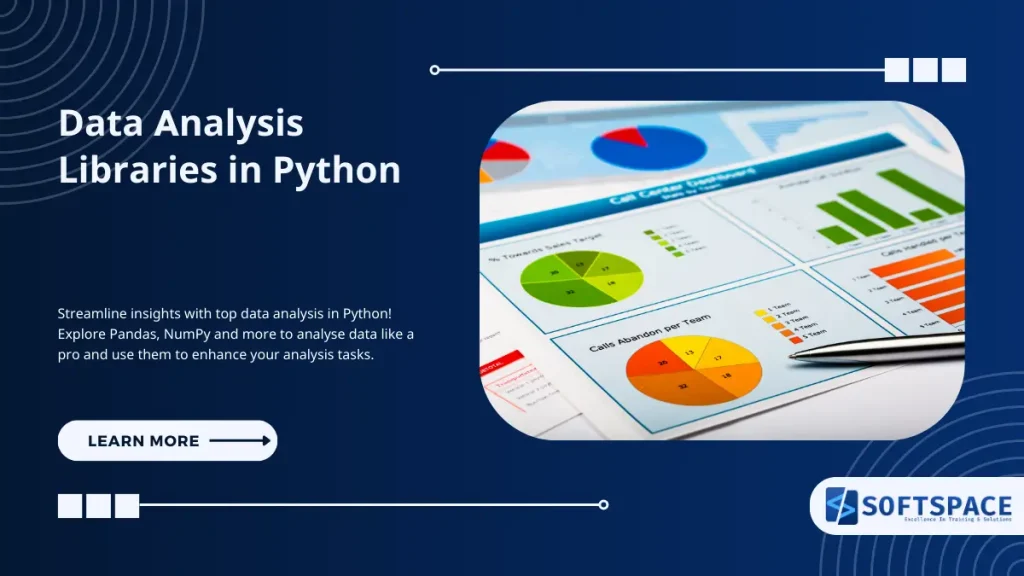Python has emerged as one of the most popular programming languages for data analysis, thanks to its simplicity, versatility, and the vast ecosystem of libraries that cater to various aspects of data manipulation, visualization, and machine learning.
These data analysis libraries for Python streamline the process of extracting insights from raw data, enabling analysts and data scientists to perform complex computations, create compelling visualizations, and build predictive models efficiently. This report provides a detailed overview of the most widely used Python libraries for data analysis in 2025, highlighting their unique features, applications, and relevance in the field.

The Importance of Data Analysis Libraries in Python
Python libraries are pre-written collections of code that provide specific functionalities, enabling users to perform data analysis tasks with minimal effort. These libraries have revolutionized the field of data science by offering tools for numerical computing, data manipulation, statistical analysis, and visualization. By leveraging these libraries, data analysts can save time, improve accuracy, and focus on deriving insights rather than reinventing the wheel.
The demand for data analysis skills continues to grow, as evidenced by the U.S. Bureau of Labour Statistics projection of a 15% increase in data science jobs from 2019 to 2029 (RedSwitches). This growth underscores the importance of mastering Python libraries for data analysis, as they are indispensable tools in the modern data scientist’s toolkit.
Python’s data analysis libraries form an ecosystem that transforms it from a general-purpose programming language into a powerful data analysis tool. Here’s why they’re so important:
- Efficiency and Performance
- Libraries like NumPy and Pandas are written in C, making them incredibly fast for processing large datasets
- They optimize memory usage and computational speed far beyond what base Python could achieve
- These optimizations mean you can analyze millions of rows of data in seconds rather than hours
- Productivity and Code Simplicity
- What might take 50 lines of base Python can often be done in 2-3 lines using Pandas
- Built-in methods handle common operations like grouping, filtering, and merging data
- Less code means fewer bugs and easier maintenance
- Ecosystem Integration
- The libraries work seamlessly together:
- Pandas for data manipulation
- NumPy for numerical operations
- Matplotlib/Seaborn for visualization
- Scikit-learn for machine learning
- SciPy for scientific computing
- Real-world Applicability
- These libraries were developed to solve actual business and research problems
- They include tools for handling missing data, time series analysis, and statistical operations
- They can handle various data formats (CSV, Excel, SQL databases, JSON) out of the box
Top Rated Data Analysis Libraries in Python
1. NumPy
NumPy (Numerical Python) is a foundational library for numerical computing in Python. It provides support for large, multidimensional arrays and matrices, along with a collection of mathematical functions to operate on these arrays.
Key Features:
- Efficient handling of homogeneous numerical data.
- Vectorized operations for faster computations.
- Integration with other libraries like Pandas and SciPy.
- Memory-efficient storage of large datasets.
Applications:
NumPy is widely used for tasks such as data manipulation, mathematical operations, and data generation. It simplifies operations like reshaping and broadcasting, making it a cornerstone of Python’s data analysis ecosystem (Code and Hack).
2. Pandas
Pandas is a powerful library for data manipulation and analysis. It introduces two primary data structures: DataFrames (2D, tabular data) and Series (1D arrays).
Key Features:
- Easy handling of structured data.
- Tools for data cleaning, reshaping, and summarization.
- Support for various file formats (CSV, Excel, SQL, etc.).
- Integration with NumPy for numerical computations.
Applications:
Pandas library is ideal for analyzing structured data in domains like business analytics, financial modelling, and operational research. It is also widely used by data journalists and researchers for data wrangling and exploration (GeeksforGeeks).
3. Matplotlib
Matplotlib is a versatile library for creating static, animated, and interactive visualizations.
Key Features:
- Support for a wide range of plot types (line, bar, scatter, etc.).
- High customizability for detailed plots.
- Integration with Jupyter Notebooks for inline plotting.
- Export options for various formats (PNG, PDF, SVG).
Applications:
Matplotlib is essential for creating detailed visualizations in data analysis workflows. Its flexibility makes it suitable for various domains, from academic research to business reporting (Lucent Innovation).
4. Seaborn
Built on top of Matplotlib, Seaborn simplifies statistical data visualization with aesthetically pleasing defaults.
Key Features:
- High-level interface for creating complex plots (e.g., violin plots, pair plots).
- Automatic handling of data frames and statistical aggregation.
- Integration with Pandas for seamless workflows.
Applications:
Seaborn is particularly useful for exploratory data analysis (EDA) and statistical visualization. It is widely used for uncovering trends and patterns in datasets (Medium).
5. SciPy
SciPy (Scientific Python) builds on NumPy and provides additional functionality for scientific computing.
Key Features:
- Modules for optimization, integration, interpolation, and statistics.
- Tools for signal and image processing.
- Support for sparse matrices and linear algebra.
Applications:
SciPy is used in fields like physics, engineering, and bioinformatics for tasks that require advanced mathematical computations (Scaler).
6. Scikit-learn
Scikit-learn is a machine-learning library that provides tools for building predictive models.
Key Features:
- Algorithms for classification, regression, clustering, and dimensionality reduction.
- Tools for model evaluation and selection.
- Integration with NumPy and Pandas.
Applications:
Scikit-learn is widely used for building machine learning pipelines, from preprocessing data to deploying models. It is a go-to library for beginners and experts alike (Python Guides).
7. TensorFlow and PyTorch
TensorFlow and PyTorch are deep learning frameworks that enable the development of neural networks.
Key Features:
- TensorFlow: High scalability, support for distributed computing, and TensorBoard for visualization.
- PyTorch: Dynamic computational graphs and ease of use.
Applications:
These libraries are used for tasks like image recognition, natural language processing (NLP), and generative modelling. They are essential for projects involving deep learning (Scaler).
8. Plotly
Plotly is an interactive visualization library that supports web-based plots.
Key Features:
- Interactive charts (e.g., 3D plots, geographic maps).
- Integration with Dash for building dashboards.
- Support for exporting plots to HTML.
Applications:
Plotly is ideal for creating interactive dashboards and presentations, making it popular in business analytics and reporting (Code and Hack).
9. Dask
Dask is a parallel computing library that extends Python’s capabilities to handle large datasets.
Key Features:
- Parallelized operations for scalability.
- Support for out-of-core computations.
- Integration with Pandas and NumPy.
Applications:
Dask is used for big data analysis, enabling analysts to work with datasets that exceed memory limits (Scaler).
Choosing the Right Library
Selecting the appropriate library depends on the specific requirements of a project. For example:
- Use NumPy for numerical computations and array manipulations.
- Use Pandas for structured data analysis and manipulation.
- Use Matplotlib and Seaborn for creating visualizations.
- Use Scikit-learn for building machine learning models.
- Use TensorFlow or PyTorch for deep learning tasks.
- Use Dask for handling large datasets.
Factors to consider include the library’s strengths, usability, community support, and scalability.
Conclusion
Python’s extensive library ecosystem has transformed data analysis, providing powerful tools for every stage of the process. From foundational libraries like NumPy and Pandas to advanced tools like TensorFlow and Plotly, these libraries empower data scientists to extract meaningful insights, build predictive models, and communicate findings effectively. As the field of data science continues to evolve, mastering these libraries will remain a critical skill for professionals in 2025 and beyond.

13+ Yrs Experienced Career Counsellor & Skill Development Trainer | Educator | Digital & Content Strategist. Helping freshers and graduates make sound career choices through practical consultation. Guest faculty and Digital Marketing trainer working on building a skill development brand in Softspace Solutions. A passionate writer in core technical topics related to career growth.



